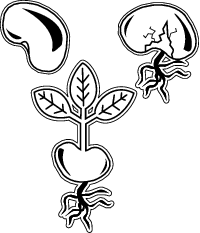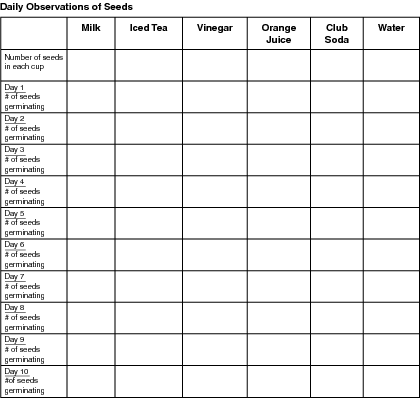what type of grass seeds to use for science experiment
Usually, when we call back about planting seeds, we recollect of planting them in the earth, or in soil that'due south been put into containers. A salubrious seed placed into soil and given the proper amounts of water, light, and oestrus will sprout, or germinate, and grow into a plant.
Merely did you know that seeds also can exist germinated in liquid? It's true. In fact, many plants can exist grown into maturity without any soil at all. Growing plants in water instead of soil is chosen hydroponics, and it'south a fascinating blazon of horticulture. Horticulture, as yous might know, is but the scientific discipline of cultivating plants. Some people refer to horticulture as an art, particularly when it pertains to decorative plants.
For this science project, withal, we're interested in seeing which liquids are best for sprouting seeds. You won't exist using hydroponics to grow plants to maturity, only that's something you might want to explore on your own.
Let'south get started now and observe out which liquids seeds grow best in.
Then What Seems to Be the Problem?
The problem, or question that you'll reply in the course of this project, is "In Which Liquid Practise Seeds Grow Best?" Following conspicuously divers steps and procedures, you lot'll solve the trouble during the course of your experiment.
By the time you've finished your experiment, you lot'll know what type of liquid the seeds you've planted similar the all-time-and the worst. Some seeds may abound quickly, and others may not grow at all. You will have answered whether seeds adopt milk, iced tea, vinegar, orangish juice, guild soda, or apparently old tap water.
Basic Elements
Hydroponics is a fancy-sounding word, merely information technology's zip more than the practice of growing plants in a water solution to which nutrients accept been added. The deviation from the regular method of growing plants, of course, is that no soil is used.
The trouble you've stated happens to also exist the suggested title of your science off-white projection. While your problem must always be a question that you're attempting to reply, your science fair title does not necessarily take to exist in question form. You lot too could utilise one of the following names as the championship for this projection:
- What's the All-time Liquid for Germinating Seeds?
- Testing Variables When Sprouting Seeds
Once you've identified and stated your trouble, y'all should accept a few minutes to think well-nigh the point, or purpose of your project.
What's the Point?
So why should you, or anybody else for that affair, give the slightest idea to sprouting seeds in different liquids? What'south the point?
Until at present, you've probably assumed that seeds sprout amend in water than in any other liquids. Right? Well, perchance they do. In this projection, water is the control, or the substance with which we'll be comparison all the other liquids. The other liquids are the variables.
But, unless you've already experimented to detect out, you can't be sure that water is the best liquid for sprouting seeds, can yous? How exercise you know that a seed placed in orange juice won't grow into a beanstalk to rival the i Jack climbed in that famous fairy tale?
The betoken of this project is to use the scientific method to solve the problem stated above and find out in which liquids seeds grow the best.
What Do You Call up Will Happen?
Earlier you lot country your hypothesis, take a few minutes to call up about the liquids in which you'll be trying to sprout bean seeds. We chose bean seeds considering they're fairly big and piece of cake to work with, and they sprout quickly, usually in about a week.
Again, the liquids you'll exist using are:
- Milk
- Iced tea
- Vinegar
- Orangish juice
- Club soda
- Water
Y'all've probably seen, smelled, and tasted nearly all of these substances. If not, you might want to exercise and then before yous come upwardly with your hypothesis.
Once you've examined the liquids you'll exist using, endeavour to remember of some means in which they might affect the seeds. Are some of the liquids more nourishing than others? Do yous recollect any of them might actually damage the seeds? Once you've given the matter some thought, y'all can make and tape your hypothesis.
Materials You'll Need for This Project
Everything you need for this project should be like shooting fish in a barrel to find. In fact, you probably already take almost of the materials in your house. If your science fair is in the middle of wintertime and you alive in a common cold climate, you lot might accept a little trouble finding bean seeds in a shop near your habitation. Everything else, notwithstanding, should be readily available. Y'all need:
- 8 ounces (240 ml) each of tap water, milk, iced tea, vinegar (either white or cider), orange juice, and club soda
- One package of bean seeds
- Six (x- or 12-ounce) (300 to 350 ml) glass or plastic cups, all the same colour and size
- Permanent mark
- Tray or shallow pan
- Metric ruler
- Paper towels
Be sure that you've cleared a space and have everything you lot'll need for your experiment earlier you get gear up to starting time. And always exist sure to bank check with a parent before you use household items such equally spectacles or markers.
Conducting Your Experiment
Remember to work carefully and in a logical manner. Endeavor not to knock over any of the glasses, and exist sure that yous write the correct names of the liquids on the spectacles. Water, club soda, and white vinegar all look pretty much the same, simply they may have very dissimilar effects on edible bean seeds.

The stages of seed germination.
- Using the permanent marker, label each of the six cups with the proper noun of the liquid it will comprise.
- Place the cups on the tray or shallow pan.
- Pour eight fluid ounces (240 ml) of h2o (your command liquid) into the cup labeled h2o.
- Pour viii fluid ounces (240 ml) of each of the other liquids into its proper cup.
- Open the package of seeds and divide them evenly into six piles. Y'all might accept a few seeds left over that you won't utilise.
- Slowly add the seeds from the first pile into the cup labeled water.
- Continue putting the other piles of seeds into each of the five remaining cups.
- Identify the tray with the cups where yous can easily observe the seeds. You'll desire to keep the temperature as constant as possible, so brand sure the seeds are in an area where there are no drafts. And, make sure the seeds won't get bumped or knocked over.
- Keep a daily record of your observations. To do so, write down how many seeds are in each cup, and how many seeds intermission their shells and begin growing, or germinating, every day. Utilise the first chart shown in the side by side section, "Keeping Track of Your Experiment," to assistance you to record your observations.
- A calendar week afterward you lot placed the seeds in the various liquids, measure out each sprout in centimeters. If your seeds haven't sprouted yet, sit tight and begin measuring them at two weeks. Yous'll demand to record the length (in centimeters) of each sprout in every cup. You lot tin can make it easier to measure the sprouts by removing each one, placing it on a paper towel, and measuring its length with a metric ruler. Once you've measured every sprout, you'll need to figure out the average length of the sprouts in each liquid.
Use the second nautical chart establish in the next section to record the average length of sprouts in each cup after one or two weeks of growth. The average length of the sprouts in each cup is another indicator of which liquid the edible bean seeds like the most.
Follow these steps to calculate the average length of all the sprouts in each of the liquids:
- Add the lengths of all the sprouts from one cup. If yous had four beans in one loving cup and each of the sprouts was i/two-inch long, for instance, your total would be 2 inches.
- Divide the total length by the number of sprouts you measured.
- The average length equals the total length divided by the number of sprouts measured.
Keeping Rail of Your Experiment
In one case you've observed and recorded everything that occurred during the course of your experiment, it's fourth dimension to nowadays this data clearly.

Utilise this chart to record your daily observations of the seeds.

Utilise this nautical chart to record the length of each sprout, in centimeters.
To do this, you'll demand to present all of the measurements you've taken. These measurements should include the following:
- The number of seeds you placed in each liquid
- The number of seeds in each liquid that began germinating on a daily basis
- The boilerplate length of seedlings in each liquid afterwards a one- or ii-week flow
All of these measurements should be neatly presented on the following charts. The number of seeds placed in each liquid and the number of seeds that germinated in each liquid should be recorded on the first chart. The average length of the seedlings should exist recorded on the second chart.
Putting It All Together
Once y'all've analyzed your data, you'll be able to summarize what you've learned, and you'll see whether your hypothesis was correct. You will have reached a conclusion, which is the last step of the scientific method. You will have answered the question posed in your trouble, and know if you were right in making your hypothesis.
Recollect that if your hypothesis turned out to be incorrect, it doesn't mean that your experiment was a failure. It just ways that the results you got were non the ones you thought you would.
The experiment part of your project has ended.
Further Investigation
Standard Process
Nearly every scientific experiment can be adjusted or modified in order to solve a similar, but not entirely the same, trouble. Don't be agape to use your scientific curiosity and remember of other questions for which you want to discover answers.
If y'all enjoyed doing this project and would similar to take information technology a step or 2 further, consider what would happen if yous grew the seeds in regular potting soil, but watered them with the different liquids you lot used for this experiment.
Maybe something in the potting soil would react favorably with orangish juice, for instance, and cause the beans to shoot up in record fourth dimension. Perhaps if you watered the seeds with Hawaiian Dial, your bean plants would produce red beans.
If you're interested in investigating this idea, just suit the steps you used when sprouting beans in the liquids. And accept fun!
Source: https://www.teachervision.com/seeds-pollination/which-liquids-do-seeds-grow-best
0 Response to "what type of grass seeds to use for science experiment"
Post a Comment